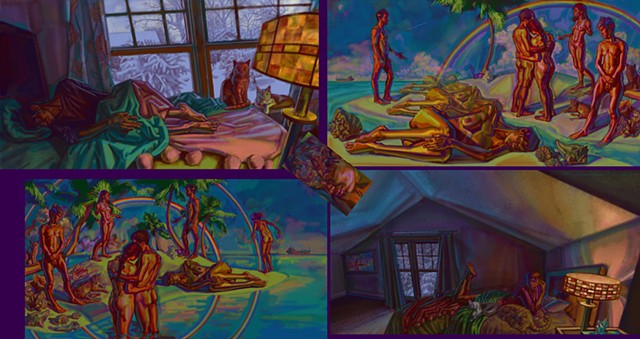Digital Paintings
* To enlarge, click over the image's upper right corner *
* For commentary about this painting, scroll down *
I arranged five digital paintings into this narrative sequence that I call "Mother of the Muses." I conceived of the five, individual paintings before I thought of putting them together to make “Mother of the Muses.” Thus, these five scenes are independent works of art and not merely parts of a whole. They are on this website as the following individual digital paintings: “Snowy-fingered Iris" (upper left image of “Mother of the Muses”), “Valentine” (upper right), “Iris’s Dream" (lower left), “Within Without” (middle, smallest, and at an angle), and “Iris’s Early Light” (lower right).
The ancient Greek God Iris is Zeus's messenger. She communicates to the Gods and mortals Zeus's directives. In Ancient Greece, the Rainbow indicates Iris's presence. The Ancient Romans thought that the Rainbow also served as Iris's principal vehicle of transportation. (See also the commentaries of "Valentine" and Iris's Dream" for my own personal feelings and experiences of rainbows). In both cultures, she is a messenger only; thus, she receives messages from Zeus that are for others only. In “Mother of the Muses” my Iris receives messages that are for her. However, it is unclear whether she receives these messages from someone or somewhere else or if they are self-created. Iris receives her messages during sleep in the form of dreams.
I want Iris’s nontraditional role in “Mother of the Muses” to ask questions about where dreams come from. I think the interplay of memory and forgetfulness in relation to a dream’s influence is important. Most think that remembering a dream is necessary for the dream to positively influence the dreamer’s life, and that forgetting a dream is detrimental to having any productive affect. I think—and I hope—to suggest the contrary.
Who creates dreams? Where are they from? Are the conjurer and dreamer the same person? Are dreams conversations or are they only a form of talking to oneself? Is it important that human beings remember dreams so that they have the fullest, most meaningful result on our lives? Do dreams allude to an immaterial plan of existence after death—an afterlife? A purely scientific interpretation favors that the dreamer is the conjurer/creator/messenger of one’s dreams and that every dreamt character is nothing more than an aspect of the dreamer; however, I hope “Mother of the Muses” and the five paintings that comprise “Mother of the Muses” evoke spiritual possibilities.
The cats are the only beings who acknowledge the presence of the viewer. In my humble opinion, they are vigilant beings who are often more aware of and notice stuff that people don’t. In other words, cats react at a feeling, heart level, which humans have trouble doing. Human beings react—more accurately, ‘think’—at what I consider a head and intellectual level. As a result, I think our fur folk can teach us a lot about how to bridge this gap between heart and head. I hope that when the viewer meets the cats' gaze, this act sensitizes viewers to consider non-scientific possibilities that might be as factual. At the very least, I want this engagement with the putties to invite the viewer to play a more active role in the story than that of a distanced, disinterested bystander.
Although I can’t remember my dreams, I think they imprint on me nevertheless and have a more meaningful result and influence than if I had remembered them. I think it is possible that memory and recalling limit the affects and effects of dreams—and by extension, the affects and effects of knowledge; thus, forgetfulness allows for a deeper, more lasting, and more significant imprint to take place. Rudolf Steiner posits that forgetfulness, not memory—of dreams and of what one has learned, that is, knowledge—is essential in acquiring wisdom. So, instead of memory loss being a bummer as one grows old, it becomes a good thing!
I decided to entitle this artwork after the Ancient Greek epithet for Mnemosyne, the God of Memory. Mnemosyne’s epithet alludes to her second important contribution to the world as the Mother of the Nine Muses. Sadly, none of the Muses represents the visual arts. The Ancient Greeks believed that the visual arts were merely craft, a status that was less elevated than the arts of lyric or epic poetry for example. No matter! My point is that memory/forgetfulness and art are linked, inspiring and informing one another, and just as much lead to wisdom as the literary arts. Visual Art will be our Tenth Muse!
